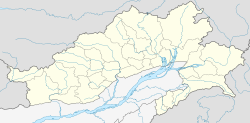Demographics
As of the 2011 census of India, [1] Roing had a population of 11,389 of which 6,064 are males and 5,325 females. Roing has an average literacy rate of 88.39%, higher than the national average of 65.38%: male literacy is 91.94%, and female literacy 84.35%. The population of children age 0-6 is 1157, constituting 10.16% of the total population of Roing.
The female Sex Ratio is 878 against the state average of 938. Moreover, the Child Sex Ratio in Roing is around 875 compared to the Arunachal Pradesh state average of 972.
Roing has total administration over 2,617 houses to which it supplies basic amenities like water and sewerage.
Both Mishmi (Idu) and Adi are the principal indigenous dwellers of Roing. Notable tourist attractions are Mehao wild life sanctuary, Sally lake, Mehao lake, Bhismaknagar Fort and Mayodia pass which remains covered with snow during peak winter. The town is located at the foothill of the Mishmi Hills. Reh festival of Idu in 1 February every year while Adi People Celebrate Solung with great joy and harmony. Towards the north flows the river Deopani that frequently floods in summer causing great economic blockade to the adjoining Dibang Valley District. Bridges over it have been repeatedly washed away draining Government's exchequer. Towards the south and east are the villages of Mishmi (Idu) and Adi extend up to Assam border. The town is the only commercial hub for Upper Dibang Valley District and the adjoining Villages under it.
Unlike other rough terrain towns of Arunachal Pradesh, Roing is geographically plain with a lot of land for farming and cultivation.
It is under the 43rd assembly constituency [ST] of the 60 constituencies in Legislative Assembly of Arunachal Pradesh. Current MLA (23-05-2019 to till date) of Roing constituency is Mutchu Mithi [2]
Languages
According to Census 2011, Nepali is Spoken by 2,216 people, Bengali at 1,694 people, Adi language by 1,424, Mismi by 1,358 people, Bhojpuri by 1,307 people, Assamese at 866 and Hindi at 799.
This page is based on this
Wikipedia article Text is available under the
CC BY-SA 4.0 license; additional terms may apply.
Images, videos and audio are available under their respective licenses.





